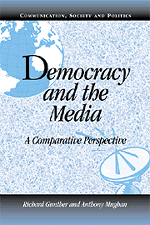Book contents
- Frontmatter
- Contents
- List of Contributors
- Acknowledgments
- 1 The Media in Democratic and Nondemocratic Regimes: A Multilevel Perspective
- 2 The Media and Politics in Spain: From Dictatorship to Democracy
- 3 Institutional Incapacity, the Attentive Public, and Media Pluralism in Russia
- 4 Democratic Transformation and the Mass Media in Hungary: From Stalinism to Democratic Consolidation
- 5 The Modernization of Communications: The Media in the Transition to Democracy in Chile
- 6 Media Influence in the Italian Transition from a Consensual to a Majoritarian Democracy
- 7 The United States: News in a Free-Market Society
- 8 Japan: News and Politics in a Media-Saturated Democracy
- 9 The Netherlands: Media and Politics between Segmented Pluralism and Market Forces
- 10 Great Britain: The End of News at Ten and the Changing News Environment
- 11 Germany: A Society and a Media System in Transition
- 12 The Political Impact of the Media: A Reassessment
- References
- Index
6 - Media Influence in the Italian Transition from a Consensual to a Majoritarian Democracy
Published online by Cambridge University Press: 05 June 2012
- Frontmatter
- Contents
- List of Contributors
- Acknowledgments
- 1 The Media in Democratic and Nondemocratic Regimes: A Multilevel Perspective
- 2 The Media and Politics in Spain: From Dictatorship to Democracy
- 3 Institutional Incapacity, the Attentive Public, and Media Pluralism in Russia
- 4 Democratic Transformation and the Mass Media in Hungary: From Stalinism to Democratic Consolidation
- 5 The Modernization of Communications: The Media in the Transition to Democracy in Chile
- 6 Media Influence in the Italian Transition from a Consensual to a Majoritarian Democracy
- 7 The United States: News in a Free-Market Society
- 8 Japan: News and Politics in a Media-Saturated Democracy
- 9 The Netherlands: Media and Politics between Segmented Pluralism and Market Forces
- 10 Great Britain: The End of News at Ten and the Changing News Environment
- 11 Germany: A Society and a Media System in Transition
- 12 The Political Impact of the Media: A Reassessment
- References
- Index
Summary
Foreign observers tend to view the Italian political scene as a kind of puzzle, as complicated as it is fascinating and incomprehensible. One French expert on Italian issues, for instance, has rather maliciously noted that his fellow countrymen tend to look on Italian politics as “strange, mysterious, paradoxical, Byzantine, irrational, illogical” (Lazar 1995, 231). These kinds of opinions can only have been strengthened by a 1994 election that saw the sudden emergence of important new political parties and the demise of old ones that had governed Italy for decades. A protracted series of center to center-left coalition governments gave way to a clear triumph of the center-right, including for the first time the postfascist Alleanza Nazionale–Movimento Sociale Italiano (AN–MSI) as a full coalition partner and a new party, Forza Italia, headed by an individual with no previous experience in elected office, the television magnate Silvio Berlusconi. The winning coalition also included the Lega del Nord (Northern League), a recently formed party emphasizing localism and capitalizing on the protest of the Po Valley regions against the Roman bureaucracy and government centralization. In addition to the wholesale replacement of majority parties and party leaders, the basic formula of government formation was altered. Indeed, the magnitude of these political changes was so substantial as to lead some to refer to this process as giving birth to a “second republic,” whose fundamental features are decidedly different from those of the previous five decades of the post-World War II era.
- Type
- Chapter
- Information
- Democracy and the MediaA Comparative Perspective, pp. 195 - 240Publisher: Cambridge University PressPrint publication year: 2000
- 16
- Cited by



